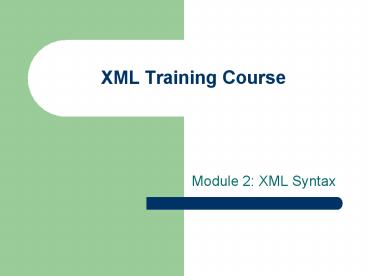XML Training Course - PowerPoint PPT Presentation
1 / 20
Title:
XML Training Course
Description:
img src= 'ham.gif' br XML requires all elements be complete img src='ham.gif' /img ... img src='ham.gif' / br / Attributes. A property of an element ... – PowerPoint PPT presentation
Number of Views:64
Avg rating:3.0/5.0
Title: XML Training Course
1
XML Training Course
- Module 2 XML Syntax
2
What to expect this Session
- What is an XML Document?
- The Prolog of an XML Document
- Elements
- Attributes
- Comments
- Processing Instructions
3
Sample Document
- Joe Schmoe
- Jane Doe
- Cal Smith
- 01/31/2003
- XML Rocks
- I just returned from Montgomery where I
attended a training session on XML provided by
the Information Services Association. At the
workshop I learned the basics about XML, like how
to create an XML document and how to present it.
I am excited to report that I have already
brainstormed several ways we can implement XML at
our institution that will provide better service
to students. I look forward to meeting with you
and sharing the knowledge and my ideas.
4
XML Document
- SGML definition a collection of information
that is processed as a unit - For this discussion, we will define it as the
contents of a single file. - That file contains tags, attributes for those
tags, and content that goes in between the tags.
5
The Prolog (Opening Section)
- The first item that should appear in any XML
document is the XML Declaration. - HTML Declaration
- XML Declaration
6
XML is Case-Sensitive
- In HTML, authors have to freedom to choose how
they write their elements. - In XML, case does matter.
- ¹ ¹
7
The Prolog (Opening Section)
- Next come the DOCTYPE construct
- This contains the instructions about how to
validate the document
8
The DOCTYPE Declaration
- A Document Type Definition (DTD) is a set of
rules that validate an XML document. - Those rules can either be written internally to
the document or they may be referenced using a
URL (or a combination of the two).
9
The DOCTYPE Declaration
- Made up of 3 parts
- Semantic Name (not filename) MEMO
- URL of the file http//www.foo.com/memo.dtd
10
The Document/Root Element
- Every XML document must have a single element
that contains all other elements. - This is known as the Root Element or the Document
Element. - In our example is the root element.
11
Document Content
- What comes next is what we traditionally think of
as the the document that is, the actual
content. - Expressed using one of 4 methods
- Elements
- Attributes
- Comments
- Processing Instructions
12
Elements
- Elements are the primary logical components of a
document. - They are bound by start tags and end tags.
- Hostess Twinkies
13
Elements
- Sometimes elements do not have any content.
These are known as empty elements. -
- XML requires all elements be complete
-
- or
-
14
Attributes
- A property of an element
- Expressed as information within the elements
start tag - Hostess Twinkies
15
Attributes
- Composed structurally of name value pairs
- All attributes values must be enclosed in
quotation marks. - Guideline Use attributes to store information
about the element.
16
Comments
- A comment written in XML is syntactically
equivalent to those found in HTML. - Comments may appear anywhere in a document,
provided they are outside other markup and not
immediately prior to the XML Declaration.
17
Processing Instructions
- Markup that provides information to be used by
software applications. - The first entry after the refers to the application for which the
instruction is intended. - The second entry tells the application exactly
what to do.
18
Rules Review
- All tags must be properly terminated with an end
tag, like this . - Tag names are case-sensitive. The following would
generate an error . - Empty tags may be defined as well and can be
expressed in one of two ways or
. - Tag data should always be enclosed in matching
single or double quotes. - The construct of tag, data, and end tag is
referred to as an element. - An element may contain other elements, as long as
the end tags of the contained elements come
before the end tag of the containing element. - Every XML document must have only one root
element that contains all other elements in the
document. - Comments are ignored by the parser and are
enclosed in comment tags .
19
Review this Session
- What is an XML Document?
- The Prolog of an XML Document
- Elements
- Attributes
- Comments
- Processing Instructions
20
Build a Complete XML Document
- You have been given a menu for a menu for a cafe.
Create an XML document that represents that menu.

